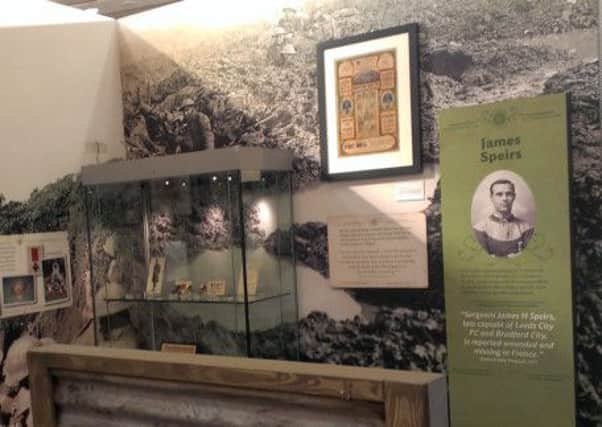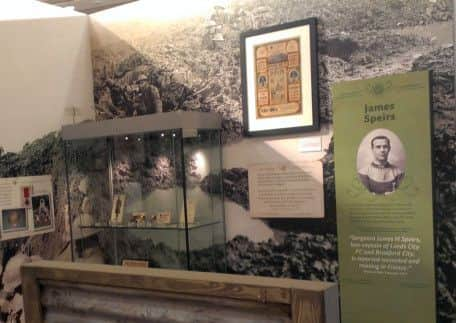Video: Yorkshire’s footballing heroes engulfed in the ‘Greater Game’


Flanked by a police guard, this most promising of young footballers seems to give a confident nod to the camera before breaking into a casual jog as he joins the rest of his Barnsley colleagues.
Two years on from the disappointment of losing the 1910 FA Cup final to Newcastle, this Second Division outfit, dubbed ‘Battling Barnsley’ were back again… and this time they would go on to finish the job as they finally beat West Bromwich Albion 1-0 in a replay at Sheffield United’s Bramall Lane.
Advertisement
Hide AdAdvertisement
Hide AdThe grainy black and white video footage of the original tie in London – a 0-0 draw played more than a century ago on April 24, 1912 – shows a game far removed from the polished Premier League action of today. Shadows of past heroes, a lasting tribute to Barnsley’s finest.


However, it is the image of outside forward Bartrop which demands your attention, footage which this week has taken pride of place at the forefront of a new exhibition at the National Football Museum in Manchester.
Bartrop was 24 when he won his FA Cup final medal; he was 26 when he left Yorkshire to join Liverpool in 1914 – but he was dead at the age of 29, killed while serving his country in the First World War, just four days before the Armistice was signed in 1918.
His promising career on Merseyside had, like so many other young players of the time, been cut short by the outbreak of war in the summer of 1914.
Advertisement
Hide AdAdvertisement
Hide AdDespite initially returning to his old job as a coal miner, Bartrop eventually joined the Royal Field Artillery and on November 7, 1918 he was hit by shrapnel during a battle close to the Belgian village of Warcoing. He is buried in the village cemetery, one of the last professional footballers to be killed in the war.
The moving story of Bartrop’s life serves as a fitting and worthy introduction to The Greater Game exhibition. The cinematic footage of the final and of the team preparing for the game, larking about at the beach, plays on a loop as you read tributes to the player from those who knew him, gaze upon photographs of the Barnsley legends and feel the glory of Bartrop’s through the presence of the winner’s medal.
Of course, Bartrop’s story is not unique. Hundreds of footballers left our shores to do their bit for King and Country, and so many of them did not come home again.
The museum’s stunning new exhibition tells their stories. Exploring the history of English football in the First World War, it brings together previously unseen material from private and public collections, and provides a moving insight into the impact of the war on our national game.
Advertisement
Hide AdAdvertisement
Hide AdFrom the very early days when football controversially continued throughout the 1914-15 season despite war being raged across Europe, to the famous Christmas truce, it shows the impact it had on those who were left at home. There is a compelling story at every turn.
The final game before football was halted, Sheffield United’s FA Cup win over Chelsea in 1915 – also known as the ‘Khaki Cup’ because most of the crowd were wearing army uniform – is featured, as is the life of Bradford Park Avenue player Donald Bell, the only English footballer to receive the Victoria Cross.
A section is dedicated to Richard Sparling, a sports journalist on the Sheffield Telegraph who quit his job to join up in 1914 and found himself serving alongside so many of the city’s footballers in the Sheffield City Battalion. He survived to write a book on his experiences.
It is, however, something of a coincidence that the most intriguing tales told in the exhibit centre around our Yorkshire FA Cup heroes and their war stories.
Advertisement
Hide AdAdvertisement
Hide AdBartrop was not the only Cup winner from these parts to die in battle, while there were others who went on to achieve final glory having lived through the horror of the trenches.
James Speirs both captained and scored the winning goal for Bradford City in the 1911 FA Cup final replay against Newcastle United at Old Trafford. Born in Glasgow, Speirs had started his career at Rangers, north of the border, before eventually finding his way down to Bradford City in 1909. He played 86 times for City, scoring 29 goals, before moving on to neighbours Leeds City in 1912. It was while he was playing for Leeds that war broke out and although Speirs continued to play during that controversial 1914-15 campaign, it was not long before the married father of two volunteered to join the Queen’s Own Cameron Highlanders.
In June, 1917, Sergeant Speirs added the Military Medal for bravery to his 1911 FA Cup winner’s medal, and a newspaper of the time recorded that ‘the numerous friends of Sergeant James H Speirs, Cameron Highlanders will be pleased to hear that in the big game across the Channel he is among the honours just as he was wont to be when he played for Glasgow Rangers, Bradford City and Leeds City.’
Three months later, Speirs was wounded and left behind on the battlefield. He was recorded as missing in action and his body was not discovered until October 1919. His army ‘dog tags’, medals and a special edition Daily Mirror front page with full picture of Speirs sitting proudly with the FA Cup are among his artefacts on display at the exhibition.
Advertisement
Hide AdAdvertisement
Hide AdBoth Tom Wilson and Samuel Wadsworth survived the war and, upon returning to England, attempted to resurrect their professional football careers with Sunderland and Blackburn, respectively.
Neither man was given the opportunity by their pre-war employers, and instead the defensive duo were snapped up by Huddersfield Town on free transfers.
Wilson joined Town in 1919 and Wadsworth followed two years later.
Sunderland’s and Blackburn’s losses would be Town’s gain as Wilson played 448 times for the club and Wadsworth 281 in an era under legendary manager Herbert Chapman that saw them win three Division One league titles and the 1922 FA Cup final.
Advertisement
Hide AdAdvertisement
Hide AdThe voice of Wadsworth booms out from above as a Fifties recording tells his life story while the last of the league championship medals won by Wilson sits alongside his military medal for bravery in a display case, together with pictures from that glorious era of Huddersfield history.
Proof that lives can be rebuilt after the ravages of war, proof that football still had a role in post-war England once the Greater Game across Europe had been played out in all its horror.
Honouring the players on the frontline
There are so many football stories associated with the First World War that the task of deciding which to feature in this new exhibition was always going to be a tough one.
Dr Alexander Jackson, collections officer at the National Football Museum, has spent the last 18 months planning and plotting with the exhibit team to come up with this most stunning collection of artefacts and recordings.
Advertisement
Hide AdAdvertisement
Hide Ad“We have been working on this for about a year-and-a-half and it is our contribution to the wider remembrance of the centenary of the First World War,” he said. “What we are trying to do is tell a little bit of the story of football in World War One, from the pre-war days, through the war years and then into the post-war period.
“We aim to tell the full story. We cover the 1914-15 season which was very controversial as it went ahead despite the war raging on in Europe.
“We tell stories of footballers playing the game at the front. Football was played by troops to raise morale in a bid to escape the horror of the trenches.
“We also look at football on the home front as well, the women who took up the sport and started to play matches and also the local clubs who kept on playing throughout the war to raise money for charity.
Advertisement
Hide AdAdvertisement
Hide Ad“The exhibition also looks at many of the post-war stories, of the men who came back from battle and tried to find a life in football.”
And in Barnsley hero Wilfred Bartrop, they found the perfect man to open their exhibit.
“The story of Wilfred Bartrop is a particularly poignant one because he was killed just a few days before the Armistice and we start the exhibition with his story.
“What is amazing with the Bartrop story is that there is film of him. To actually see someone running, living and breathing gives you a whole new aspect and makes it more real.”
Advertisement
Hide AdAdvertisement
Hide Ad* The exhibition at the National Football Museum in Manchester will remain open to the public right through until September, 2015.
There is also an associated website link where supporters can call-up a club-by-club link showing all of those footballers who served in the First World War. This can be found at:
footballandthefirstworldwar.com